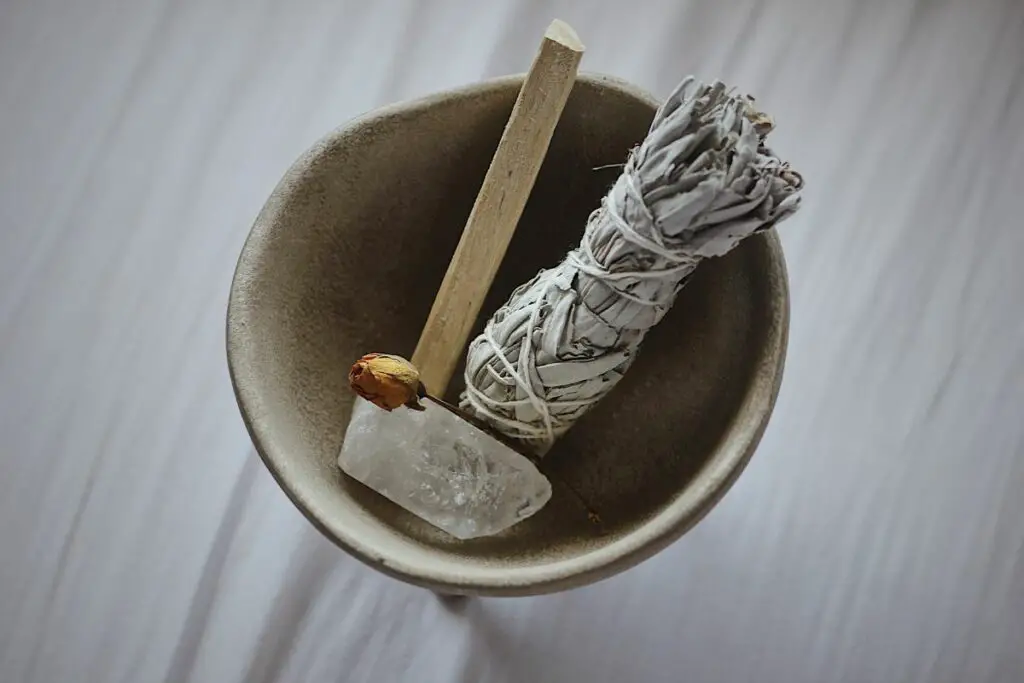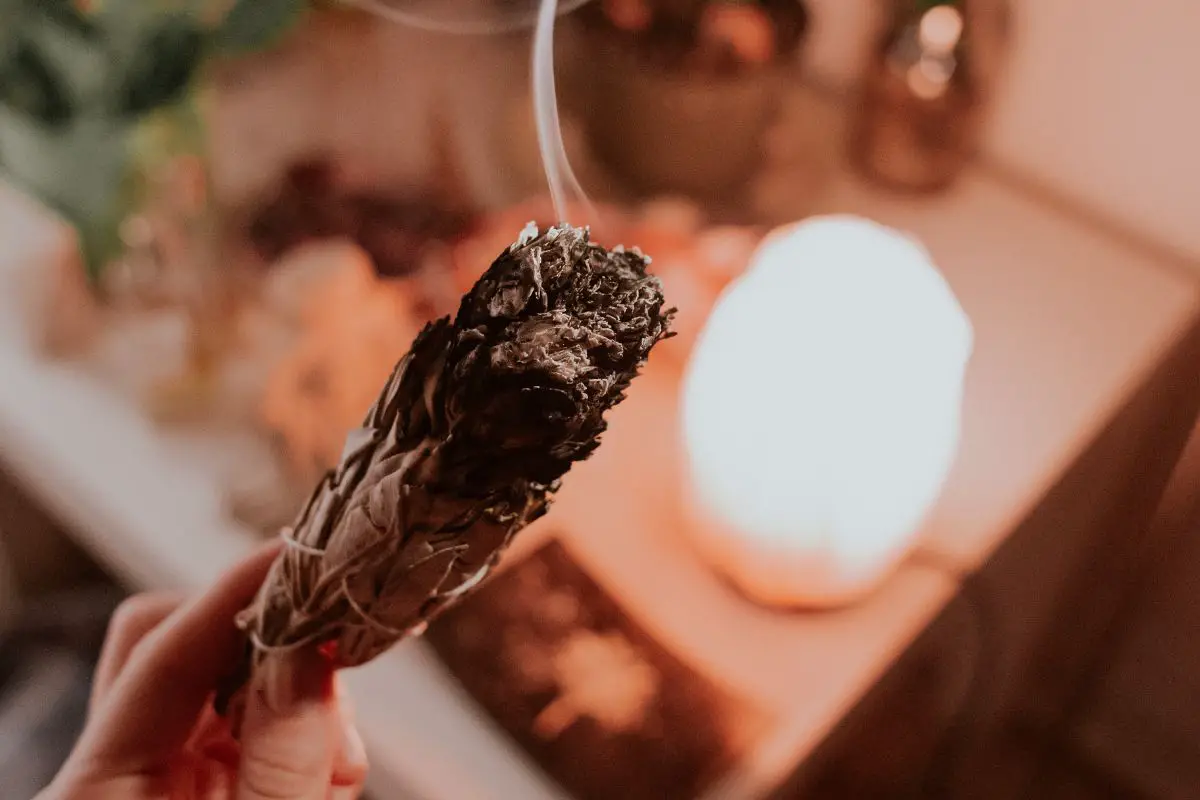The aroma of burning sage can be a polarizing experience; while it’s a traditional practice valued by many for cleansing and spiritual purposes, the distinct smell doesn’t agree with everyone’s olfactory senses.
If the scent of burning sage is too strong or even unpleasant for you, it’s possible that your unique preferences or heightened sensitivity to smells could be playing a role.
When the aroma of sage leads to discomfort such as headaches or nausea, understanding your response to scents is crucial.
If this is the case, managing your exposure to sage and exploring alternatives can be an integral part of creating a harmonious environment that aligns with both your spiritual practices and scent preferences.
From choosing the right kind of sage to proper storage and preparation, tweaking how you interact with this aromatic herb could make all the difference.
Understanding Sage
Sage is a multifaceted herb that plays a significant role in cooking, healing, and spiritual rituals. Its unique aroma can be polarizing; you might find it either soothing or rather potent. Here’s a quick overview to help you get acquainted:
- Aromas: Varies from earthy and musky to grassy notes.
- Culinary Uses: Enhances flavors in recipes like stuffing and soups.
- Medicinal Uses: Believed to have calming properties.
Sage’s scent is subjective—while some compare it to fresh foliage, others may feel it’s too intense. Your own sensory preferences are perfectly normal, as everyone’s sense of smell is different.
In practices such as smudging, sage is used to cleanse spaces, but remember, it’s not the only option available. Feel free to explore alternatives if sage’s scent doesn’t agree with you.

Here’s a brief snapshot:
| Use | Description |
|---|---|
| Culinary | Adds depth to dishes with its robust flavor. |
| Medicinal | Used for its supposed stress-relieving qualities. |
| Spiritual | Employed in rituals like smudging for purification. |
Remember, your experience with sage is unique to you, so embrace what works best for your senses and practices.
Why Sage May Smell Bad
Personal Preferences
Smells are subjective, and you might find the aroma of sage to be unpleasant if it’s not to your liking. It’s a strong scent that varies greatly from person to person. For some, sage might even trigger physical discomfort such as headaches or nausea. Remember, what appeals to your nose may differ for someone else.
Quality and Freshness
The scent of sage can be influenced by its quality and freshness. Dried sage may not be as aromatic as fresh sage and can sometimes develop an off-odor if it’s not stored properly. To enjoy the full fragrance of sage, consider these tips:
- Opt for sage from trustworthy suppliers
- Store sage in a cool, dry place
- Keep sage sealed to maintain freshness
Environmental Factors
The environment plays a role in how sage is perceived by your nose. Different factors can blend with and affect the natural scent of sage:
- Competing scents from incense or other aromatic materials
- The smell of burning sage which combines smoke and heat
To understand and enjoy the scent of sage, pay close attention to how these environmental factors might be influencing your experience.
How to Improve Sage’s Smell
Choosing the Right Sage
Discovering a sage variety that appeals to your senses can significantly enhance your experience with this versatile herb. Consider sampling the nuanced fragrances of different types to find your perfect match.
For a gentler and somewhat sweeter aroma, you might want to try bergamot sage. Renowned for its use in natural products, it might just be the scent you’re looking for.
Exploring diverse sage types isn’t just about the smell; it’s also about the aura they create. White sage, for instance, is embraced for its calming properties and memory enhancement. Take the time to experience each scent; what works for others may not be your personal favorite.
Proper Storage and Preparation
Your method of keeping and using sage can alter its fragrance. Here’s how to make sure your sage stays as aromatic as desired:
- Storage: Sage keeps its scent best when stored out of the sun in a cool, dry location. Airtight containers are excellent for keeping unwanted odors at bay.
- Preparation: Before utilizing sage, try gently crushing the leaves in your hand to activate their natural oils and fragrances. If you’re burning sage, tip it at a 45-degree angle after lighting. Allow it to burn briefly, then blow it out to let the smoke carry the sage’s full aroma.

Your personal taste in fragrance is uniquely yours, which is why it’s essential to enjoy the process of finding and preparing your ideal sage variety. Remember, a little experimentation can lead to finding a scent that not only smells great but also brings comfort and tranquility to your space.
Alternatives to Sage
When sage isn’t quite your thing, consider these friendly substitutes for cleansing or cooking:
For Cleansing:
- Palo Santo Wood: Emits a sweet scent and is believed to bring positivity.
- Essential Oil Sprays: Blends of cedar, sweetgrass, and sage create refreshing aromas.
- Rosemary: Its woodsy fragrance makes it ideal for spiritual use.
- Lavender: Soothing and tranquil, perfect for creating a calm atmosphere.
- Cedar: Known for its purifying properties with a fresh scent.
- Juniper: Thought to offer protection, it’s a robust sage alternative.
For Cooking:
- Embrace the vibrant taste of rosemary for a similar yet distinct flavor.
- Use it judiciously to not overpower your dishes.
